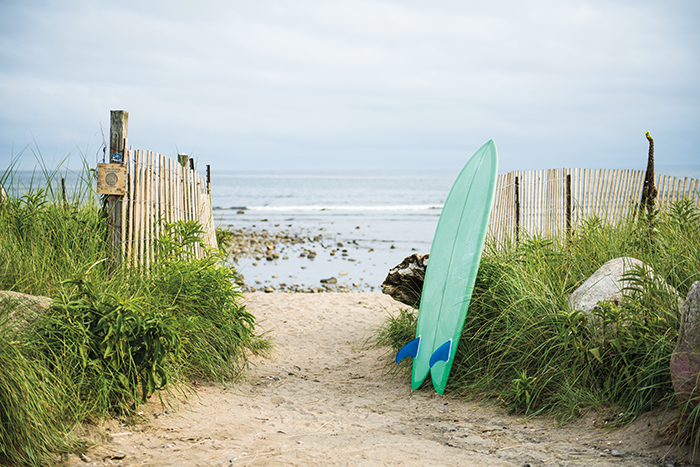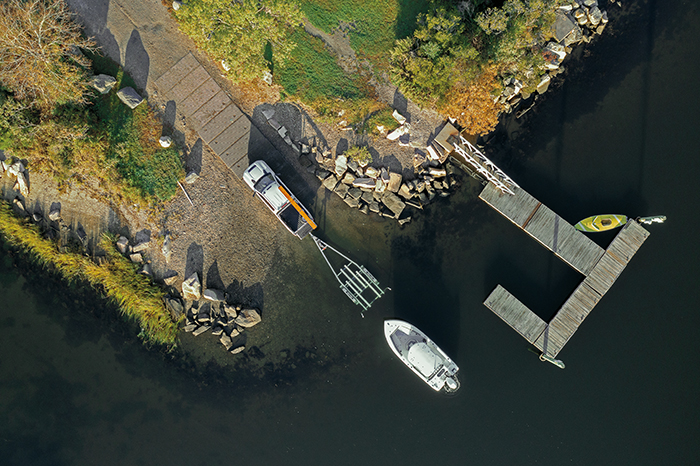Whose Right?
Coastal Access is Constitutional but Controversial
By Todd McLeish | Cover Photograph by Cate Brown“Surfers have accessed these sites for decades,” said David Prescott, Save The Bay’s South County coastkeeper and a long-time surfer himself, “so we need to figure out how to make public access here work better.”
Another block away, at the end of Conant Avenue, a well-marked public right-of-way features a modest stone staircase to the shore and attractive plantings welcoming visitors to use the site. Signs clearly indicate that parking is allowed on the shoulder of the road during the day, the result of the Narragansett Town Council reversing earlier parking prohibitions imposed by the previous council. Yet area neighbors have sued the town in hopes of returning the neighborhood to a no-parking zone.
“There has always been parking available in the area, and those access points are especially popular after big storms, when a lot of people go there,” Prescott said. “Those access points need parking nearby so people can get down to the shore and enjoy it.”
Public access to the coast and along the shore has long been controversial in Rhode Island, even though the right to coastal access is enshrined in the state constitution. Waterfront landowners often object to seeing residents walking along the shore in front of their properties, and many coastal property owners have gone so far as to block public rights-of-way, install unofficial “no parking” signs, and call the police on those they consider trespassers.
Plantings often obstruct public shoreline access sites. This right-of-way on Esplanade Road in Middletown has been described by an abutter as a “view access point” (page 9) although state records contradict that claim.
A stairway just a few feet north of this right-of-way provides direct access to the shore, but it is privately owned and not for public use.
Photograph by Rhode Island Sea Grant
Much of the conflict arises from the uncertainty of where members of the public are legally allowed to walk along the shore and where they can park to access designated rights-of-way. The state of Rhode Island is now taking steps to clarify the issue. The Rhode Island Constitution clearly states that “the people shall continue to enjoy and freely exercise all the rights of fishery, and the privileges of the shore.”
In 1986, that language was updated at a constitutional convention to clarify that those privileges include walking along the shore and entering the water to swim. But what remains unclear is where private waterfront property rights end and public use begins. A shoreline trespassing case brought to the Rhode Island Supreme Court in the 1980s defined the dividing line as the mean high tide line, which is determined by averaging the high tides over an 18.6-year lunar cycle. Yet all interested parties agree that it is impossible for anyone walking along the shore to know the location of that line on any given day.
While the state constitution addresses what is referred to as lateral access along the shoreline, it does not indicate how the public can get from the nearest road to the shoreline, or perpendicular access, and that has become equally controversial. The state Legislature has charged CRMC with designating public rights-of-way to the shore, and the agency is proactively seeking to identify approximately 420 rights-of-way, one for every mile of shoreline in the state. Nearly 230 have already been designated, with more added every year.
But Willis said the agency cannot create new rights-of-way. Instead, it conducts the legal research in state and municipal property records to unearth existing rights-of-way that may not be known or may have become impeded through the years. Because CRMC has a limited budget to conduct legal research, it has partnered with the Roger Williams University Law School to use law students to conduct the initial research. When enough documentation is uncovered to suggest that a right-of-way should be designated, the evidence is presented to CRMC’s right-of-way subcommittee, which makes a recommendation to the full council.
Designating a public access right-of-way doesn’t necessarily mean that Rhode Islanders can use the site, however, if access has been obstructed or there is nowhere to park. Those are the most common criticisms of the right-of-way designation process. Prescott said that Save The Bay conducts assessments of each right-of-way every three years, and in 2018 it found that 37% were obstructed and only 48% had parking nearby.

One member of the Facebook group who spends a great deal of time familiarizing himself with the issues is Dave Lombardi, who is especially concerned about coastal access for disabled Rhode Islanders.
“There’s so much healing power in the ocean,” he said, “and we need places where we can feel hopeful. The shoreline has a healing, hopeful message for us, but getting to the shore can be especially difficult for those with disabilities.”
Parking and signage are Lombardi’s biggest concerns. “There are a lot of sites in Warwick that are road-end rights-of-way, but there are no signs, you can’t easily access the shore, and abutters make you feel intimidated if you don’t know your shoreline rights,” he said. “People think you’re suspicious for being there, and if the right-of-way isn’t clearly delineated, those abutters can convince you that you shouldn’t be there.”
Lombardi spends much of his free time learning about coastal access issues, advocating for the needs of those with disabilities, and visiting public rights-of-way to take photos and share them with officials who can take steps to address any necessary deficiencies.
“The Coastal Resources Management Council can only do so much,” Lombardi said. “To fix the system, we’re probably going to have to deal with the state legislature. Things need to change on a political level to resolve this issue.”
State legislators are beginning to listen. Rep. Terri Cortvriend, a Democrat who represents Portsmouth and Middletown, originally became interested in coastal access as a way of addressing sea level rise and climate change, but she soon became fascinated with the historical aspect of the issue, the many court cases, and the constitutional convention. She initially tried to resolve the issue by amending the state’s trespassing laws so those who unintentionally cross onto private property by less than 10 feet above the mean high tide line would not be prosecuted. But that approach ultimately failed.
So she teamed with Republican House Minority Leader Blake Filippi to introduce a bill to establish a legislative commission to study coastal access rights, which passed the General Assembly at the end of the 2021 session. The commission, which is focusing exclusively on addressing lateral rights along the shoreline, held its first meeting on August 26. According to Cortvriend, the group of 12 appointed members is scheduled to issue a report with its recommendations by March 31, in time for legislation to be introduced before the end of the 2022 legislative session.
“We need to come up with something that the average person can see, and it shouldn’t be under water,” Cortvriend said. “If we don’t do anything, people will continue to argue. We have this constitutional amendment but no legislative action taken. So we tell Rhode Islanders that they have this right, this privilege to the shore via the constitution, and we rely on a court case to determine where that is. I don’t see a way that it changes without some kind of legislation to more clearly define it.

Shoreline access in North Kingstown’s Wilson Park was recently added to the state’s official rights-of-way by the Coastal Resources Management Council.
Photograph by Rhode Island Sea Grant
“We’ve got some coastal scientists studying where the mean high tide line is right now, bringing their equipment to the same spot on Matunuck Beach and measuring where that line is,” she added. “The fact that you need to have fancy equipment to determine where it is at any particular time makes it clear that the common person walking along the shore won’t know where that spot is, especially along the dynamic shores in South County.”
The outcome of the commission is being watched closely, not only by coastal access advocates but also by waterfront property owners concerned that legislation may infringe upon their property rights. While noise and litter are frequently cited by property owners as reasons to oppose expanded access to the shore, many are especially worried that the trespass legislation originally filed by Cortvriend could be reintroduced, and they see it as an unconstitutional taking of their property.
Last spring, a number of waterfront property owners—including private individuals, nonprofit organizations, and commercial businesses—formed
a group called Shoreline Taxpayers Association for Respectful Traverse, Environmental Responsibility and Safety, or starters, to lobby against the legislation.
“That legislation could come back, or the study commission could find that the statute is the best way to address the issue,” said lobbyist Christopher Boyle, who represents starters. “We acknowledge the long history of constitutional law as to the rights to the shore and the right to traverse the shoreline, but the question becomes, where does public land end and private property begin. That specific statute would shift that line by at least 10 feet onto private property. We argue that would come under the ‘taking’ clause of the Rhode Island and federal constitution, and, if passed, the property owners would have to be compensated.”
Compensation for property owners isn’t on the minds of most residents trying to get to the shore. For some visitors, the issue is more about social justice instead. Despite the increasing numbers of officially designated coastal access sites around the state, consid- erable disparities remain among different demographic groups seeking to access the coast. Data from a study by the Environmental Protection Agency (EPA) suggests that Caucasian people have easier access and need travel a shorter distance to get to clean and safe coastal waters than those of other racial and ethnic groups.
According to Leah Feldman, CRMC’s coastal policy analyst, the report’s findings note an “obvious and distinct difference” in coastal access. “There’s a large vocal group of Rhode Islanders who are pushing for protection of public access rights,” she said, “but it’s important to highlight not only the basic public access structure but also the underserved voices that may not be heard.”
While she said that the disparities aren’t a clear-cut distinction between urban and suburban access—since inequities occur in many communities—she notes that crmc is giving more attention to coastal rights-of-way in urban areas. In fact, the agency’s most recent right-of-way designation was at the end of Public Street in South Providence. Ownership of the property had been unclear for many years, leading abutting commercial and industrial property owners to encroach on one of the few shoreline access points in the area.

The public may enjoy rare urban opportunities to walk coastal trails or fish at Save The Bay’s center in Providence.
Photograph by Rhode Island Sea Grant
“We in South Providence are severely landlocked, and we are in a terribly polluted area, [but] hopefully this will unlock us and give us public access to the water.”
While more rights-of-way in urban communities will improve shoreline access for minority residents, it will not necessarily get them to clean, swimmable waters, which is the point of the EPA report.
“At the moment, the focus is on providing more access points,” said Feldman. “We’re working diligently to improve the cleanliness and safety of the water, too. Our partners, like Save The Bay and the Department of Environmental Management, have done incredible work to improve the quality of water, even in more urban areas. And we’re working to improve the parking infrastructure at the rights-of-way we currently have. The Department of Transportation is also putting forward impressive efforts to improve public transport to coastal areas, like the free beach bus to Newport.”
Despite the popularity of the beaches in the Newport area, however, public access to the shore in other parts of Aquidneck Island may be more limited than anywhere else in the state. The western shoreline of the island from the Newport Bridge to the Mount Hope Bridge in Portsmouth has not one state-designated right-of-way, and the east side has just two rights-of-way north of Third Beach.
That’s a major sticking point for Dave McLaughlin, founder of Clean Ocean Access, a nonprofit group based in Middletown that advocates for increased coastal access, the cleanup of marine debris, and improved water quality around Aquidneck Island. A surfer and former IT consultant, he took up the cause of shoreline access in 2006 after being told he had parked illegally while surfing in Newport. As he fights for additional access points around the island, he is also leading the way in serving as a steward of existing rights-of-way.
“You can lose your rights quickly if you don’t use them,” he said, “so a huge part of our program is to get people out to the rights-of-way to use them. We encourage people to pick a right-of-way and walk it every week for the rest of their life.”
His organization has formally adopted 31 rights-of-way on Aquidneck Island, keeping them clean and well-maintained throughout the year. McLaughlin has also helped the recreational fishing community protect access points around Newport’s Ocean Drive. Despite the positions taken by Clean Ocean Access, McLaughlin also understands the perspective of coastal property owners who seek the tranquility of living on the shore and their desire to avoid having anyone walk behind their house.
“Public access is a very volatile issue, and all it takes is a couple bozos who leave litter and play loud music at all hours to ruin it,” he said. “If I were a waterfront owner, I wouldn’t want those people there either. So we have to find a balance between recreation and accommodating the property owners where you’re doing it [recreation].”
Just like in Narragansett, however, achieving that balance varies widely from place to place. On Esplanade Road in Middletown, for instance, where “no parking” signs are abundant, a well-marked right-of-way crosses a beautifully manicured lawn and ends after 30 feet, where attractive plantings block a 10-foot rocky cliff that prohibits visitors from getting to the water. The abutting neighbor calls it a “view access point” that was never intended as a site to enter the water.
One hundred yards away, a second well-marked right-of-way is a narrow, overgrown path bounded on both sides by the concrete foundations of abutting houses. At the water’s edge, visitors have nowhere to go and no way to enjoy the site. Another hundred yards further and the road becomes Shore Drive, which appears to be a private gravel driveway for several elegant homes. A sign indicates a public access point, and the right-of-way is clean and easy to traverse, but there is no parking anywhere nearby.
“The limitation here is the approach,” said McLaughlin. “It gives the sense that it’s private. There’s a public right-of-way without obstructions, but it’s really only accessible to the neighbors.”
A short drive away, an access point on Tuckerman Avenue offers a 30-foot-wide corridor accessible to vehicles, but stormwater runoff has made the dirt road a rutted mess that should only be attempted by high-clearance, four-wheel-drive vehicles. Next to the nearby Clam Bake Club of Newport, a right-of-way to Easton’s Point popular with surfers is very overgrown and surrounded by “no parking” signs.
At every one of these sites, visitors could rightfully question whether the rights-of-way actually provide public access to the shoreline. Despite the considerable progress that has been made toward the state’s goal of providing shore access points for every mile of the coastline, there remains much work to be done.
CRMC ArcGIS Map Rights-of-Way
Contact Us
Telephone: (401) 874-6805
Email: allard@uri.edu
Contributor Guidelines
Please review submission guidelines to be considered. d

